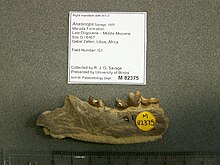Anasinopa
izumrli rod placentalni sisara
Anasinopa (Anasinopa — „suprotno Sinopi”) je izumrli rod placentalnih sisara iz izumrle potporodice Teratodontinae i izumrle porodice Teratodontidae, koji je u periodu ranog miocena nastanjivao područje Afrike i Azije.[3][4][5][6]
| Anasinopa Vremenski raspon: rani miocen
| |
|---|---|

| |
| dio donje vilice vrste Anasinopa leakeyi | |
| Naučna klasifikacija | |
| Domen: | Eukaryota |
| Carstvo: | Animalia |
| Tip: | Chordata |
| Klasa: | Mammalia |
| Red: | †Hyaenodonta |
| Natporodica: | †Hyainailouroidea |
| Porodica: | †Teratodontidae |
| Potporodica: | †Teratodontinae |
| Rod: | †Anasinopa Savage, 1965 |
| Tipska vrsta | |
| †Anasinopa leakeyi Savage, 1965
| |
| Vrste | |
| |
| Sinonimi | |
Etimologija naziva
uredi| Rod: | Porijeklo naziva od: | Značenje naziva: |
|---|---|---|
| Anasinopa | suprotno Sinopi |
| Vrste: | Porijeklo naziva od: | Značenje naziva: |
|---|---|---|
| A. haasi |
|
hasova Anasinopa |
| A. leakeyi |
|
likijeva Anasinopa |
| A. libyca |
|
libijska Anasinopa |
| A. napaki |
|
Anasinopa iz Napaka |
Opis
urediZubna formula kod vrsti iz ovog roda je 3.1.?4.33.1.4.3.[7] Vrsta Anasinopa leakeyi je težila oko 25,42 kg i dostizala veličinu sivog vuka.[7][8]
Sistematika
urediKlasifikacija
uredi| Vrste: | Rasprostranjenost fosila i lokacija: |
Vremenski raspon: |
|---|---|---|
| †A. haasi (Tchernov, 1987)[9] | Izrael (Južni okrug) | 20,0 do 16,0 mil. god. |
| †A. leakeyi (Savage, 1965)[7] | Kenija (ostrvo Rusinga i okrug Kisumu) | 17,8 do 15,0 mil. god. |
| †A. libyca (Morales, 2010)[10] | Libija (okrug Vahat) | 19,0 do 15,0 mil. god. |
| †A. napaki (Savage, 1965) | Uganda (Sjeverni Region)[11][12] | 20,0 do 15,0 mil. god. |
Filogenija
urediDolje prikazan kladogram predstavlja filogenetske veze roda Anasinopa.[13][14][15][16][17][18]
| †Teratodontidae |
|
†Kyawdawia grupa | |||||||||||||||||||||||||||||||||||||||||||||||||||||||||||||||||||||||||||||||||||||||||||||
Vremenska rasprostranjenost roda Anasinopa unutar porodice Teratodontidae
uredi
Vidi još
urediReference
uredi- ^ Matthew R. Borths; Nancy J. Stevens (2017). „The first hyaenodont from the late Oligocene Nsungwe Formation of Tanzania: Paleoecological insights into the Paleogene-Neogene carnivore transition”. PLOS ONE. 12 (10): e0185301. Bibcode:2017PLoSO..1285301B. PMC 5636082 . PMID 29020030. doi:10.1371/journal.pone.0185301.
- ^ L. Van Valen (1967.) "New Paleocene insectivores and insectivore classification." Bulletin of the American Museum of Natural History 135(5):217-284
- ^ McKenna, Malcolm C.; Bell, Susan K. (1997). Classification of Mammals Above the Species Level. New York: Columbia University Press. ISBN 978-0-231-11012-9. Pristupljeno 16. 3. 2015.
- ^ S. Peigné, M. Morlo, Y. Chaimanee, S. Ducrocq, S. T. Tun and J. J. Jaeger (2007.) "New discoveries of hyaenodontids (Creodonta, Mammalia) from the Pondaung Formation, middle Eocene, Myanmar—paleobiogeographic implications." Geodiversitas 29(3):441-458
- ^ Margaret E. Lewis and Michael Morlo (2010.) "Creodonta". In: Lars Werdelin and William Joseph Sanders (eds.) "Cenozoic Mammals of Africa". University of California Press, Berkeley, London, New York, pp. 543-560
- ^ Solé, F.; Lhuillier, J.; Adaci, M.; Bensalah, M.; Mahboubi, M.; Tabuce, R. (2013). „The hyaenodontidans from the Gour Lazib area (?Early Eocene, Algeria): implications concerning the systematics and the origin of the Hyainailourinae and Teratodontinae”. Journal of Systematic Palaeontology. 12 (3): 303—322. doi:10.1080/14772019.2013.795196.
- ^ a b v R. J. G. Savage (1965.) "Fossil Mammals of Africa: The Miocene Carnivora of East Africa." Bulletin of the British Museum (Natural History) Geology 10(8):241-316
- ^ Therese Flink (2019.) "The neurocranium of Anasinopa leakeyi (Hyaenodonta, Mammalia) – a First Insight into Teratodontine Brain Morphology" Degree Project at the Department of Earth Sciences, Uppsala University, Uppsala
- ^ Tchernov, E., Ginsburg, L., Tassy, P. & Goldsmith, N.F. (1987.) "Miocene Mammals of the Negev (Israel)." Journal of Vertebrate Paleontology, vol. 7(3), pp. 284-310.
- ^ Morales, J., Brewer, P. & Pickford, M. (2010.) "Carnivores (Creodonta and Carnivora) from the basal Middle Miocene of Gebel Zelten, Libya, with a note on a large amphicyonid from the Middle Miocene of Ngorora, Kenya." Bulletin of the Tethys Geological Society, Cairo, vol. 5, pp. 43-54.
- ^ J. Morales, M. Pickford and D. Soria (2007.) "New carnivoran material (Creodonta, Carnivora and Incertae sedis) from the Early Miocene of Napak, Uganda." Paleontological Research 11(1):71-84
- ^ Jorge Morales; Martin Pickford (2017). „New hyaenodonts (Ferae, Mammalia) from the Early Miocene of Napak (Uganda), Koru (Kenya) and Grillental (Namibia)” (PDF). Fossil Imprint. 73 (3–4): 332—359. doi:10.2478/if-2017-0019.
- ^ Borths, Matthew R.; Stevens, Nancy J. (2017). „Deciduous dentition and dental eruption of Hyainailouroidea (Hyaenodonta, "Creodonta," Placentalia, Mammalia)”. Palaeontologia Electronica. 20 (3): 55A. doi:10.26879/776 .
- ^ Matthew R. Borths; Nancy J. Stevens (2019). „Simbakubwa kutokaafrika, gen. et sp. nov. (Hyainailourinae, Hyaenodonta, 'Creodonta,' Mammalia), a gigantic carnivore from the earliest Miocene of Kenya”. Journal of Vertebrate Paleontology. 39 (1): e1570222. doi:10.1080/02724634.2019.1570222.
- ^ Floréal Solé; Bernard Marandat; Fabrice Lihoreau (2020). „The hyaenodonts (Mammalia) from the French locality of Aumelas (Hérault), with possible new representatives from the late Ypresian”. Geodiversitas. 42 (13): 185—214. doi:10.5252/geodiversitas2020v42a13.
- ^ Solé, F.; Morlo, M.; Schaal, T.; Lehmann, T. (2021). „New hyaenodonts (Mammalia) from the late Ypresian locality of Prémontré (France) support a radiation of the hyaenodonts in Europe already at the end of the early Eocene”. Geobios. 66-67: 119—141. doi:10.1016/j.geobios.2021.02.004.
- ^ Flink, T.; Cote, S. (2021). „The neurocranium of Ekweeconfractus amorui gen. et sp. nov. (Hyaenodonta, Mammalia) and the evolution of the brain in some hyaenodontan carnivores”. Journal of Vertebrate Paleontology. 41 (2): e1927748. doi:10.1080/02724634.2021.1927748.
- ^ Averianov, Alexander; Obraztsova, Ekaterina; Danilov, Igor; Jin, Jian-Hua (2023). „A new hypercarnivorous hyaenodont from the Eocene of South China”. Frontiers in Ecology and Evolution. 11. ISSN 2296-701X. doi:10.3389/fevo.2023.1076819/full.